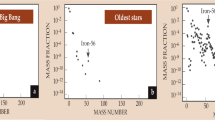Abstract
To understand the origin and character of individual radioactive emissions accompanying nuclear transformation processes, it is essential to understand what an unstable nucleus is, what its motivation is to transform, and how the nucleus selects the best way to transform. The following chapter represents part I of a series of two articles. It introduces the composition of stable atomic nuclei, the meaning of “isotopes”, the discrepancy between the mass of the nucleus and the sum of the mass of the nucleons it is composed of (the “mass defect”), and the parameter of “mean nucleon binding energy”. It is the fate of those unstable nuclei, that they transform to more stable ones. Part I will focus on the “primary” pathways of those transformations, i.e., those, where the nucleon composition of an unstable nucleus is modified to gain mean nucleon binding energy. Those transformation processes are the origin of certain radioactive emissions, and part I will discuss those originating from the primary transformation pathways, i.e., mainly β- and α-emissions.

































Similar content being viewed by others
Notes
Of course, in the inanimate world terms like “personal motivations” or “wishes” etc. are incorrect wording. There is no “fate” of unstable nuclei or of emitted positrons etc. However, those terms are utilized in few examples throughout the text to make the physics more susceptible to the understanding of the reader.
There are more examples of how mass is transformed into energy (e.g. the annihilation of a positron and an electron), but also examples of the opposite (the pair formation pathway in secondary transitions, where an amount of ΔE = 1022 keV is transformed into two particles, the electron and the positron, with exactly owing the mass equivalent of this energy), see part II.
References
Vértes A, Nagy S, Klencsár Z, Lovas RG, Rösch F (eds) (2011) Handbook of nuclear chemistry, 6 volumes, 2nd edn. Springer, Berlin-Heidelberg
Rösch F (2014) Nuclear- and radiochemistry. Volume I: Introduction. Walter de Gruyter, Berlin/Boston, p 471
Rösch F (ed) (2016) Nuclear- and radiochemistry. Volume II: Modern applications. Walter de Gruyter, Berlin/Boston, p 581
AMDC—Atomic Mass Data Center—IAEA Nuclear Data Services (2017) This page contains data provided by the Atomic Mass Data Center. https://www-nds.iaea.org/amdc/. Accessed 29 Aug 2017
Huang WJ, Audi G, Wang M, Kondev FG, Naimi S, Xu X (2017) Atomic mass evaluation—AME2016. (I). Evaluation of input data; and adjustment procedures. Chin Phys C 41:030002
Wang M, Audi G, Kondev FG, Huang WJ, Naimi S, Xu X (2017) Atomic mass evaluation—AME2016. (II). Tables, graphs and references. Chin Phys C 41:030003
Interactive masses and reaction data for all nuclides across the periodic table. Provided by national nuclear data center, Brookhaven National Laboratory. http://www.nndc.bnl.gov/chart. Accessed 29 Aug 2017
Wieser ME, Berglund M (2009) Weight of natural elements. Pure Appl Chem 81(11):2131–2156
Chart of Nuclides (2010) Nuclear Data in Nucleonica, Karslruhe
Author information
Authors and Affiliations
Corresponding author
Rights and permissions
About this article
Cite this article
Rösch, F. Nuclear transformations and radioactive emissions: Part I—primary transformation pathways of unstable nuclei. ChemTexts 4, 13 (2018). https://doi.org/10.1007/s40828-018-0068-x
Received:
Accepted:
Published:
DOI: https://doi.org/10.1007/s40828-018-0068-x




